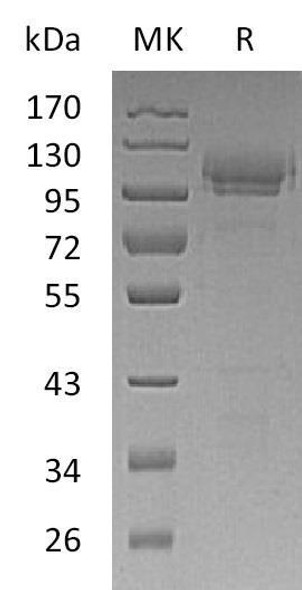Description
| Product Name: | Human CADM1 Recombinant Protein |
| Product Code: | RPPB2960 |
| Size: | 10µg |
| Species: | Human |
| Target: | CADM1 |
| Synonyms: | Cell Adhesion Molecule 1, Tumor Suppressor In Lung Cancer1, IGSF4, Spermatogenic Immunoglobulin Superfamily, Immunoglobulin Superfamily,Member 4, Immunoglobulin Superfamily Member 4, Synaptic Cell Adhesion Molecule,Nectin-Like Protein 2, Nectin-Like 2, Necl-2, SgIGSF, IGSF4A, SYNCAM, TSLC-1,TSLC1, NECL2, Immunoglobulin Superfamily, Member 4D Variant 1, Immunoglobulin Superfamily,Member 4D Variant 2, TSLC1/Nectin-Like 2/IGSF4, Truncated CADM1 Protein,STSLC-1, SynCAM1, RA175, ST17, BL2, Cell adhesion molecule 1. |
| Source: | Escherichia Coli |
| Physical Appearance: | Sterile Filtered colorless solution. |
| Formulation: | CADM1 protein solution (0.25 mg/ml) containing Phosphatebuffered saline (pH7.4), 10% glycerol and 1mM DTT. |
| Stability: | Store at 4°C if entire vial will be used within 2-4 weeks. Store, frozen at -20°C for longer periods of time. For long term storage it is recommended to add a carrier protein (0.1% HSA or BSA).Avoid multiple freeze-thaw cycles. |
| Purity: | Greater than 85.0% as determined by SDS-PAGE. |
| Amino Acid Sequence: | MGSSHHHHHH SSGLVPRGSH MGSQNLFTKD VTVIEGEVAT ISCQVNKSDD SVIQLLNPNR QTIYFRDFRPLKDSRFQLLN FSSSELKVSL TNVSISDEGR YFCQLYTDPP QESYTTITVL VPPRNLMIDI QKDTAVEGEEIEVNCTAMAS KPATTIRWFK GNTELKGKSE VEEWSDMYTVTSQLMLKVHK EDDGVPVICQ VEHPAVTGNL QTQRYLEVQY KPQVHIQMTYPLQGLTREGD ALELTCEAIG KPQPVMVTWV RVDDEMPQHA VLSGPNLFIN NLNKTDNGTY RCEASNIVGKAHSDYMLYVY DPPTTIPPPT TTTTTTTTTT TTILTIITDS RAGEEGSIRA VDH |
Cell Adhesion Molecule 1, also known as CADM1 belongs to the nectin family. CADM1 mediates homophilic cell-cell adhesion in a Ca2+-independent manner as well as mediating heterophilic cell-cell adhesion with CADM3 and PVRL3 in a Ca2+-independent manner.�Furthermore, CADM1 perform as a tumor suppressor in non-small-cell lung cancer, NSCLC, cells. The interaction with CRTAM promotes natural killer (NK) cell cytotoxicity & IFN-gamma secretion by CD8+ cells in vitro over and above NK cell-mediated rejection of tumors expressing CADM3 in vivo.
CADM1 Human Recombinant produced in E.Coli is a single,non-glycosylated polypeptide chain containing 353 amino acids (45-374 a.a) andhaving a molecular mass of 39.4 kDa.CADM1 is fused to a 23 amino acid His-tag at N-terminus& purified by proprietary chromatographic techniques.
| UniProt Protein Function: | CADM1: a single-pass type I membrane protein that ediates homophilic cell-cell adhesion, and heterophilic cell-cell adhesion with CADM3 and PVRL3 in a Ca(2+)-independent manner. Acts as a tumor suppressor in non-small-cell lung cancer (NSCLC) cells. Interaction with CRTAM promotes natural killer (NK) cell cytotoxicity and interferon-gamma (IFN-gamma) secretion by CD8+ cells in vitro as well as NK cell-mediated rejection of tumors expressing CADM3 in vivo. May contribute to the less invasive phenotypes of lepidic growth tumor cells. In mast cells, may mediate attachment to and promote communication with nerves. CADM1, together with MITF, is essential for development and survival of mast cells in vivo. May act as a synaptic cell adhesion molecule that drives synapse assembly. May be involved in neuronal migration, axon growth, pathfinding, and fasciculation on the axons of differentiating neurons. May play diverse roles in the spermatogenesis including in the adhesion of spermatocytes and spermatids to Sertoli cells and for their normal differentiation into mature spermatozoa. Belongs to the nectin family. 2 isoforms of the human protein are produced by alternative splicing. |
| UniProt Protein Details: | Protein type:Apoptosis; Cell adhesion; Membrane protein, integral; Tumor suppressor; Vesicle Chromosomal Location of Human Ortholog: 11q23.2 Cellular Component: basolateral plasma membrane; cell-cell adherens junction; integral to plasma membrane; intercellular junction; plasma membrane Molecular Function:cell adhesion molecule binding; PDZ domain binding; protein binding; protein homodimerization activity; receptor activity; receptor binding Biological Process: activated T cell proliferation; cell recognition; detection of stimulus; heterophilic cell adhesion; homophilic cell adhesion; positive regulation of cytokine secretion; positive regulation of natural killer cell mediated cytotoxicity; susceptibility to natural killer cell mediated cytotoxicity; T cell mediated cytotoxicity |
| UniProt Code: | Q9BY67 |
| NCBI GenInfo Identifier: | 150438862 |
| NCBI Gene ID: | 23705 |
| NCBI Accession: | Q9BY67.2 |
| UniProt Secondary Accession: | Q9BY67,Q86WB8, Q8N2F4, A4FVB5, F5H0J4, H0YGA7, H1ZZV9 H1ZZW1, H1ZZW2, X5D2C8, |
| UniProt Related Accession: | Q9BY67 |
| Molecular Weight: | 45,624 Da |
| NCBI Full Name: | Cell adhesion molecule 1 |
| NCBI Synonym Full Names: | cell adhesion molecule 1 |
| NCBI Official Symbol: | CADM1�� |
| NCBI Official Synonym Symbols: | BL2; ST17; IGSF4; NECL2; RA175; TSLC1; IGSF4A; Necl-2; SYNCAM; sgIGSF; sTSLC-1; synCAM1�� |
| NCBI Protein Information: | cell adhesion molecule 1 |
| UniProt Protein Name: | Cell adhesion molecule 1 |
| UniProt Synonym Protein Names: | Immunoglobulin superfamily member 4; IgSF4; Nectin-like protein 2; NECL-2; Spermatogenic immunoglobulin superfamily; SgIgSF; Synaptic cell adhesion molecule; SynCAM; Tumor suppressor in lung cancer 1; TSLC-1 |
| Protein Family: | Cell adhesion molecule |
| UniProt Gene Name: | CADM1�� |
| UniProt Entry Name: | CADM1_HUMAN |









